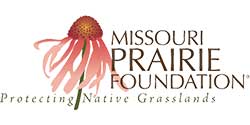Prairie Protection Meets Native Plant Power
With more than 2,000 native plant species, abundant rivers and streams, springs, and caves, and eighty-five distinct natural communities, Missouri’s native biodiversity is incredibly rich. Among the state’s habitats are twelve prairie types–reduced through land changes from a total of fifteen million acres before statehood to fewer than 45,000 scattered acres today.
The mission of the 59-year-old Missouri Prairie Foundation (MPF) is to protect and restore prairie and other native grassland communities through land acquisition, management, education, and research; to promote the use of native plants through its 25-year-old Grow Native! program; and to support the early detection and control of invasive plants through its administration of the Missouri Invasive Plant Council.
One facet of MPF’s work is to share the many benefits of integrating prairie plants on farms—including as forage for cattle production, as seed crops to support the native landscape industry, and as crop buffers to protect soil and water by establishing prairie strips. Prairie strips are linear, perennial plantings of prairie grasses and wildflowers within and/or around corn and soybean fields. Through CP-43, a continuous CRP program, farmers can receive federal cost-share and rental payments to offset the cost of establishing this agricultural conservation practice.
Since 2021, thanks to a multi-year grant agreement with Iowa State University (ISU) to promote prairie strips, MPF has provided an additional reward to farmers to enroll in CP-43: an ecosystem service incentive payment. As of May 2025, MPF has provided payments to 16 Missouri farmers who established prairie strips, for a total of 132 acres of strips.
MPF also organized prairie strips field days in 2021 and 2022, hosted by corn and soybean farmers. The ISU grant also funded the prairie strips video, featured on this site.


